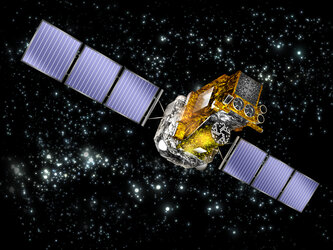XMM-Newton: pulsed heartbeat of a weird new type of star
XMM-Newton has detected periodic X-ray emission, or the pulsed heartbeat of a weird new type of star. Collecting the X-rays from the so-called rotating radio transient has confirmed the nature of the underlying celestial object and given astronomers a new insight into these exotic objects.
The observations were made using XMM-Newton’s European Photon Imaging Camera (EPIC), which targeted the celestial object RRAT J1819–1458. Astronomers observed the object for around 12 hours and detected pulsations in the X-ray data that show the source to be rotating once every 4.26 seconds.
Previously, astronomers had only seen radio outbursts from this object. It erupts every three minutes or so with a brief burst of radio emission lasting just 3 milliseconds. Such behaviour defines the object as a rotating radio transient (RRAT).
The RRATs were announced in February 2006. Eleven objects were found using the Parkes radio telescope. Astronomers suspected that RRATs were neutron stars, the compact remnants of dead stars made of neutrons and measuring just 10–12 km across yet containing more matter than the Sun. They are therefore extremely dense. Most observed neutron stars are radio pulsars; rotating quickly and sweeping lighthouse beams of radiation across space that make them appear to pulsate. The RRATs, however, were only detected through their radio bursts.
The new XMM-Newton observations show that periodic emission, linked to the object’s rotation, can be detected in X-rays. “It is now definite that RRATs are rotating neutron stars as we can see the 4.26-second rotation period of the RRAT in the X-ray data,” says Maura McLaughlin, West Virginia University, USA, who took the lead in the research.

In addition to the identification of the underlying celestial object from the discovery of the X-ray pulsations, XMM-Newton also revealed another facet of the RRAT’s behaviour. Something appears to be absorbing certain frequencies of the X-rays after they are emitted from the surface of the neutron star.
The absorption could either be happening in an atmosphere of gases surrounding the neutron star or by particles trapped in the neutron star’s magnetic field. If the second reason is the cause of the absorption, it would indicate that the magnetic field of this RRAT is strong.
“We can’t say for sure where the absorption is coming from with these observations,” says Nanda Rea, University of Amsterdam, Netherlands. She estimates that an observation twice as long would collect enough data to determine where the absorption is taking place.
She also hopes to follow-up this observation by targeting other RRATs. Before that can happen, however, the team must refine the positions they have for these objects. To do this, they continue to observe the RRATs with radio telescopes across the world, timing the outbursts. From careful measurements of the arrival times of the bursts over the course of the year, their positions in the sky can be determined more accurately. Once these locations are known, X-ray telescopes can be pointed in their direction.
Since the original discovery of 11 RRATs, McLaughlin’s team has found an additional 10. This indicates that they may form a substantial population in the Milky Way, with over
Notes for editors:
Discovery of pulsations and a possible spectral feature in the X-Ray emission from rotating radio transient J1819–1458 by M. McLaughlin, N. Rea, B. Gaensler, S. Chatterjee, F. Camilo, M. Kramer, D. Lorimer, A. Lyne, G. Israel, and A. Possenti is published in The Astrophysical Journal.
For more information:
Maura McLaughlin, West Virginia University, USA
Email: maura.mclaughlin @ mail.wvu.edu
Nanda Rea, University of Amsterdam, the Netherlands
Email: nrea @ science.uva.nl,
Andrew Lyne, Jodrell Bank Observatory, UK
Email: andrew.lyne @ manchester.ac.uk
Bryan Gaensler, University of Sydney, Australia
Email: bgaensler @ usyd.edu.au
Norbert Schartel, ESA XMM-Newton Project Scientist
Email: Norbert.Schartel @ esa.int















 Germany
Germany
 Austria
Austria
 Belgium
Belgium
 Denmark
Denmark
 Spain
Spain
 Estonia
Estonia
 Finland
Finland
 France
France
 Greece
Greece
 Hungary
Hungary
 Ireland
Ireland
 Italy
Italy
 Luxembourg
Luxembourg
 Norway
Norway
 The Netherlands
The Netherlands
 Poland
Poland
 Portugal
Portugal
 Czechia
Czechia
 Romania
Romania
 United Kingdom
United Kingdom
 Slovenia
Slovenia
 Sweden
Sweden
 Switzerland
Switzerland






































